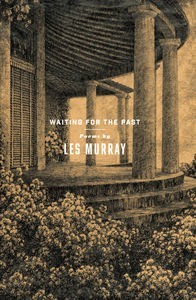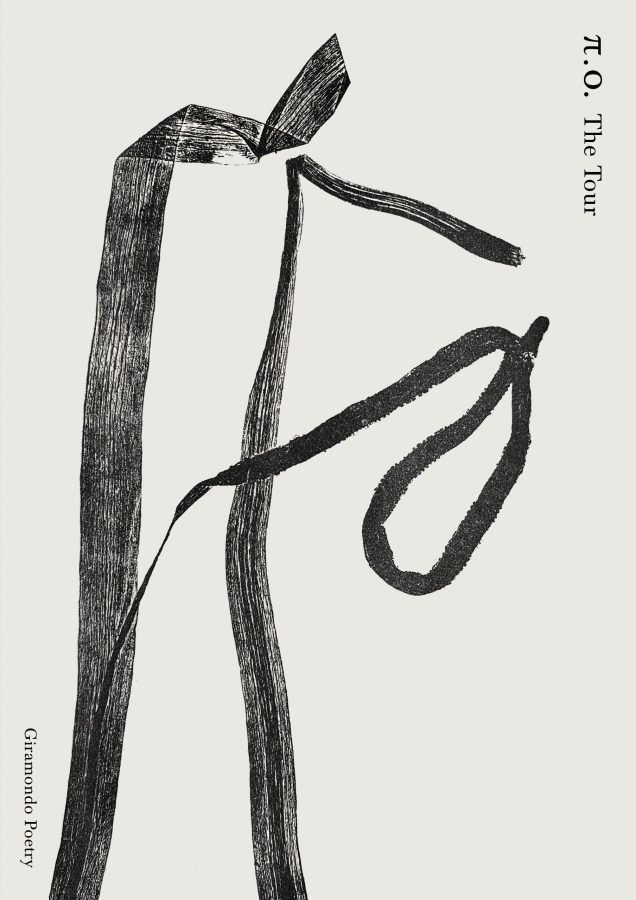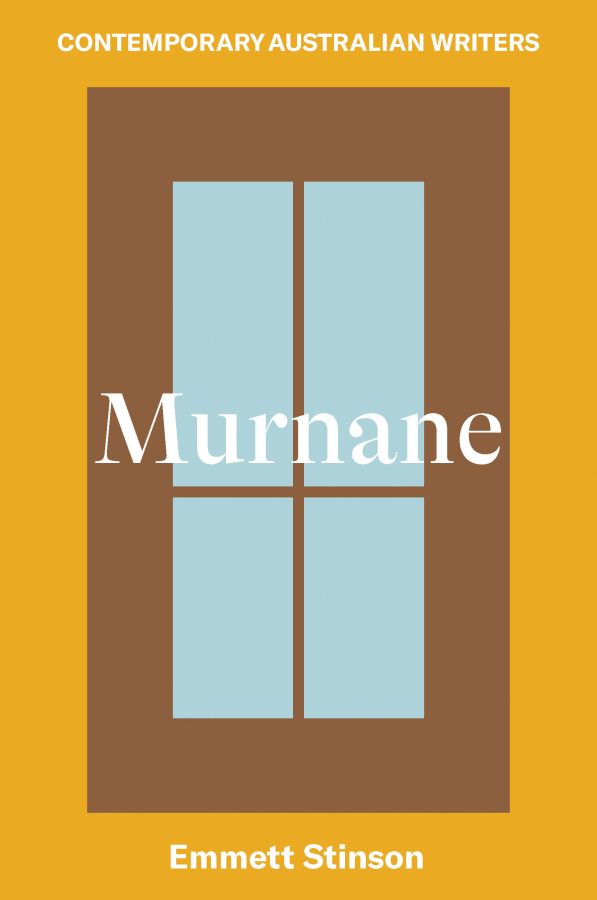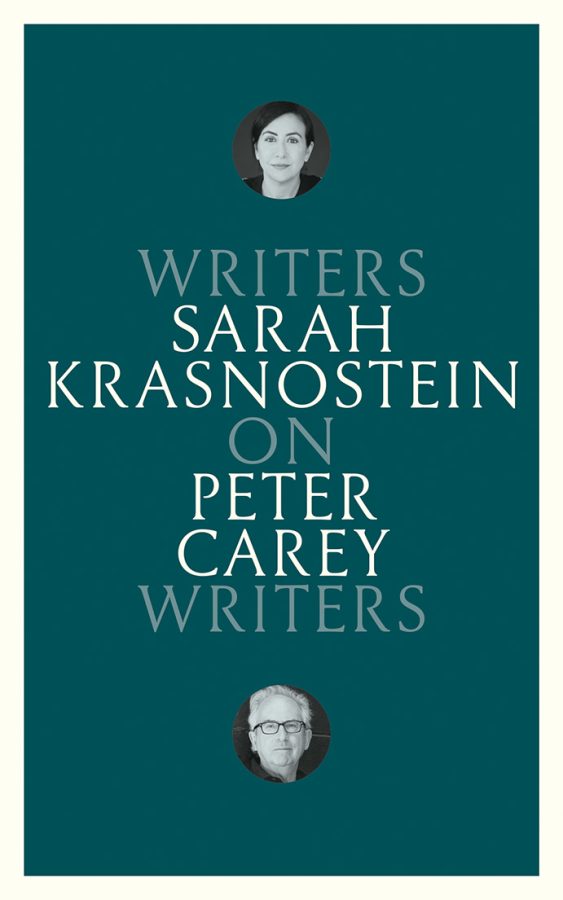The wave, over the wave, a weird thing I saw,
through-wrought, and wonderfully ornate:
a wonder on the wave – water became bone.
This is a riddle from the Exeter Book, an anthology of Anglo-Saxon poetry, which the Bishop Leofric donated to the library of Exeter Cathedral in 1072: ‘I mycel englisc boc be gehwilcum thingum on leothwisan geworht’: a big English book about everything, worked into song.
Riddles are at the heart of Les Murray’s poetry: that language-gift of his, which shows words to be sounds that strangely hold for us those meanings that we attribute to the world. As he remarks in his poem ‘The Meaning of Existence’:
Everything except language
knows the meaning of existence.
In a riddle what the words mean does not displace how they sound until the riddle is solved. Until the riddle is solved, it could mean anything – everything. Only after it is solved does meaning settle into being in the words: a strange transformation, something like the one this riddle describes: water becoming bone.
Murray’s descriptions have a riddle ancestry: they effect an estrangement that is perceptual. That is why, for all the force of the poet’s personality and reputation, Murray’s best poems are distinguished by the fact that reading them feels solitary: an encounter not with a personality but with language itself: its work of discovering the world through its patterns of sound. In his introduction to his essay collection A Working Forest (1997), Murray characterises prose as ‘narrowspeak’ and poetry as ‘widespeak’. For all the self-assertive tenor of his ‘narrowspeak’, many of Murray’s most intimate poems address himself in the second person, as though one of the pleasures that poetry offers is an encounter with things – places, creatures, even memories – beyond the strictures of a social self.
While his prose works to define boundaries, Murray’s poetry takes up its forms, modes, subjects, tones, situations and influences freely from all over the place. He has a poem titled ‘Jellyfish’; Marianne Moore has one titled ‘A Jelly-fish’. Robert Gray has a poem about a train journey called ‘Journey: the North Coast’; Murray has one called ‘On the North Coast Line’. Andrew Marvell describes people carrying boats on their backs in his long poem about a building, ‘Upon Appleton House’:
But now the Salmon-Fishers moist
Their Leathern Boats begin to hoist;
And like Antipodes in Shoes,
Have shod their Heads in their Canoes …
Murray, in ‘Clothing as Dwelling as Shouldered Boat’ from Poems the Size of Photographs (2002), his compressed poem about Sydney Opera House, describes indigenous Australians
with their naked backs to the weather,
clothing as dwelling as shouldered boat
beetle-backed …
Murray’s commitment to Bunyah, place of his childhood and present life, has perhaps blinded critics to how widely and impartially his poetry ranges across the poetic tradition: reading, as much as place, is a dream-source of his writing. What makes it all his own is the peculiar intensity of his language, which combines what might have seemed separate things: compressed thought, close-worked sound patterns, and a child’s direct and sudden phrasing.
In The Earliest English Poems (1966), Michael Alexander argues that riddles renew the primordial act of giving things names. Murray dedicates all his books ‘To the glory of God’, as though for Murray the work of naming has a spiritual dimension. ‘Religions are poems,’ he writes in ‘Poetry and Religion’ from The Daylight Moon (1987): ‘They concert / our daylight and dreaming mind’. He includes a riddle in ‘Machine Portraits with Pendant Spaceman’ from The People’s Otherworld (1983):
The more I act, the stiller I become;
the less I’m lit, the more spellbound my crowd;
I accept all colours, and with a warming hum
I turn them white and hide them in a cloud.
To give long life is a power I’m allowed
by my servant, Death. I am what you can’t sell
at the world’s end—and if you’re still beetle-browed
try some of my treasures: an adult bird in its shell
or a pink porker in his own gut, Fritz the Abstract Animal.
When he writes, ‘I accept all colours, and with a warming hum / I turn them white and hide them in a cloud’, Murray recalls, I think, a mystical work of Middle English, The Cloude of Unknowyng:
If to any man the tumult of the flesh grew silent, silent the images of earth and sea and air, and if the heavens grew silent, and the very soul grew silent to herself and by not thinking of self mounted beyond self …
‘Silent the images of earth and sea and air’: one contemporary image for this is a person in space; and the riddle in ‘Machine Portrait with Pendant Spaceman’ comes shortly after Murray’s description of the speaker as an astronaut. ‘Gold masked, the foetal warrior / unslipping on a flawless floor’: even that epithet ‘foetal warrior’ works like a compressed riddle. The astronaut says:
the home world now seems outside-in;
I marvel here that background’s so fore
and sheathe my arms in the unseen …
Murray’s descriptions are never far from paradox, very often combining a close-up view of something with a sense of its strangeness.
Most of Murray’s descriptions could start with that phrase from the riddle: ‘a weird thing I saw’. Take his seven-line poem ‘Whale Sounding’ in Waiting for the Past:
… thick roof tail
spilling salt rain
off onto wallowing
upthrust all around,
bubba dog down.
The solution is in the title, so why does this description still seem to work like a riddle? Murray achieves a riddle’s dislocation of perspective by stripping back prepositions and articles, those parts of speech so familiar they insensibly establish a here and there. This is characteristic of his work and explains why, for all his love of place, his descriptions often have a floating quality, as though he is not so much describing a place as dreaming it up in words.
Suddenly the bush was America:
dark woods and in them like snow.
The highway was miles of bath house,
bulk steam off ice shovelled over blue …
So starts his poem ‘Early Summer Hail with Rhymes in O’ from Biplane Houses (2006). If the phrasing of that second line recalls a child’s phrasing, that is because the syntax follows an ‘order of perception’ (to borrow the title of another Murray poem) not yet reordered by prepositions into those structures of closeness and distance, inside and outside, which organise our understanding of place. Murray renews the language as much through his use of prepositions and pronouns as anything: his syntax places simple words in a complex relationship which makes the mind work backwards even as it advances. Take ‘Birthplace’, for instance: a poem which ends, ‘and drive in to be held to it’.
Murray’s poetry takes much of its energy from the way his words change meaning as the poem advances. This work of transformation is characteristic – in the brilliant title ‘High Speed Trap Space’, for instance, the words speed and trap seem to transform from noun to adjective as you read. Reading ‘Whale Sounding’, it is hard to tell whether a word is working as an adjective, verb or noun: ‘roof’, which could be a noun, is an adjective; the same for ‘salt’; and although ‘spilling’ is a verb, ‘wallowing’ works as an adjective. Which is an action, which is a thing, which is the look of a thing? Murray’s poems often hold such categories of thought in suspense; it gives his writing its strange electric charge.
‘Whale Sounding’ also works like a riddle because of the way it plays with sound. A poem such as ‘Bat’s Ultrasound’ is a flamboyant performance; probably it is the poem that most suggests a debt to Gerard Manley Hopkins:
we air our array,
err, yaw, row wry – aura our orrery,
our eerie ü our ray, our-arrow …
But Hopkins wrote:
When I consider my selfbeing; my consciousness and feeling of myself, that taste of myself, of I and me above and in all things, which is more distinctive than the taste of ale and alum … Nothing else in nature comes near this unspeakable stress of pitch, distinctiveness, and selving, this selfbeing of my own …
In his poems (unlike his prose writings), Murray almost never works with such ‘stress of pitch’. Unlike Hopkins, his sound-play characteristically works not with consonants but with those subtler breath sounds, vowels. Here, and often, he repeats a sequence of vowel sounds with minor variations: ‘outside of towns… wire compounds’ (‘Sun Taiko’); ‘still re-melt and pour … silvery ichor’ (‘I Wrote a Little Haiku’); ‘carry off sheaves, // tie dye, mai tai, taupe lingeries …’ (‘The Backroad Collections’).
In Waiting for the Past, Les Murray also works rhymes subtly across his stanzas. ‘A Denizen’ is a poem of four quatrains. Within each quatrain, he sets up rhymes that make another pattern against the visual. For instance, in the second stanza –
Old legerdemain of eight
died of too much chlorine
applied to purify the amenities
of urine and algal slippage
– ‘urine’ echoes ‘chlorine’, with a nice aptness, but urine sounds well before the end of the line. In this way, the rhyme sets up a second time scheme in the poem, something like the sense of the past in the present that the poem describes. More playfully, in the first stanza ‘sea tiles’ makes what you might call a reversed rhyme with ‘Wylies’ (tiles sea). As this might suggest, Les Murray favours sound-patterns over strict rules of form. In this, too, he draws on an oral poetic tradition, a way of forming the poem not through counted measures and structured end-rhymes, but through repeating patterns of alliteration and assonance, recollected sound.
Waiting for the Past is a work deeply interested in memory: the past catching up. (The collection also shares its title with a 1994 Smashing Pumpkins album; I can see no reason for this and assume it is coincidental.) It considers, in terms of the poet’s own life, the question that he raises in his poem ‘The Welter’ from Biplane Houses:
How deep is the weatherfront of time
that advances, roaring and calm
unendingly between was and will be?
A millisecond? A few hours? All secular life
worldwide, all consequences of past life
travel in it. It’s weird to move ahead of …
Many of the poems in Waiting for the Past look back into that ‘weatherfront of time’; others move weirdly ahead of it:
Later comes the sunny day when
street detail gets whitened to mauveand people hurry you, or wait, quiet
(‘Vertigo’)
That valedictory note sounds repeatedly through this collection:
And we drove on down
at just the speed which made our tyres buzz
like the small wheels of a bed that would divide us.
Much of the feeling in these poems comes from the ways in which they move in and out of memory, so that what they describe is lost and resurrected at the same time.
At the heart of these poems is the marvellous ‘Self and Dream Self’.
Routines of decaying time
fade, and your waking life
gets laborious as science.You huddle in, becoming
the deathless younger self
who will survive your dreams
and vanish in surviving.Dream brings on its story
at the pace of drift
in twilight, sunless colour,its settings are believed,
a library of wood shingles,
plain mythic furniture…
‘Dream brings on its story’ – even in the narrative poems of this collection, Les Murray works with memory as a strange condition of time, a force which makes possible doublings of self, along with furniture that is at once plain and mythic because it has entered that dream condition which is the past. Language is the one medium equal to it.
*
In his 1978 review-essay ‘On Sitting Back and Thinking about Porter’s Boeotia’, Murray characterises his own work as Boeotian and Peter Porter’s as Athenian. He fits thousands of years of poetry into this simple binary:
What is at issue are two contrasting models of civilization between which Western man has vacillated … In the past, Athens, the urbanizing, fashion-conscious principle removed from and usually insensitive to natural, cyclic views of the world, has won out time and again, though the successes of Boeotia have been far from negligible.
The problem with this argument is typified by Murray’s claim that Virgil ‘worked his way as it were backwards through Arcadian art – an Athenian style evolved to deal with Boeotian material in an emasculated way – in his Theocritean Eclogues to the pure Boeotian mode of his Georgics and thence to the epic…’ But Virgil’s pastoral is formally elegant, even urbane, and highly politic, working with ironies and symbols, speaking to Caesar and of Caesar. Virgil and Horace had more in common than Murray’s binary opposition allows. What the essay shows, I think, is that Murray’s idea of human history is not so much epic as gnomic, again in the Anglo-Saxon tradition as Michael Alexander characterises it: gnomic verses, or ‘maxims’, describe patterns in natural change and human behaviour, something ritual in the way things happen. ‘Most such palaces died of equality’ (‘Radiant Pleats, Mulga’); or, ‘the idle svelte would dine apart / once designer chefs had risen …’ (‘The Glory and Decline of Bread’): maxims such as these bring a sudden abstractness to Murray’s poetry.
As Alexander observes, this view of history makes a role for the poet as ‘the keeper of the traditions which hold the cynn (kin) together’. This idea of the poet may form part of Les Murray’s interest in the etymology of words. The word ‘weird’ in Murray’s poem ‘The Welter’ is a case in point: ‘It’s weird to move ahead of …’ The word is Old English: wierd. Alexander writes:
this all-important word is related to weorthan, to be, become or happen. It means ‘what is, what happens, the way that things happen. Fate, personal destiny, death.’
The etymology of the word opens its meaning out from the conversational phrase. The conversational tone of some of Les Murray’s opening lines belies how closely worked his poetry is, and how involved with poetic tradition. Take this description in ‘Midsummer Ice’, for instance, a short poem in memory of his mother:
It stopped good things rotting
and it had a strange comb at its heart,
a splintered horizon rife with zero pearls
The last line may be the most beautiful in all his poetry. Murray rarely talks about the poets who have influenced his work. However, for all its simplicity, behind this poem lies a long history of images. Along with that Anglo-Saxon riddle, there is Shakespeare’s song for a drowned father ‘Full Fathom Five’: ‘those are pearls that were his eyes’. There is T. S. Eliot’s ‘Little Gidding’:
The brief sun flames the ice, on pond and ditches,
In windless cold that is the heart’s heat …
Where is the summer, the unimaginable
Zero summer …
Possibly that word ‘rife’, being an anagram of fire, recalls Robert Frost’s great short poem ‘Fire and Ice’, which begins ‘Some say the world will end in fire, / Some say in ice’ – itself indebted to the gnomic verses that begin, ‘Frost shall freeze / fire eat wood …’ Ice and water, stoppedness and flood – word by word the poem opens out into that history of experience which we inherit as we read.
In Waiting for the Past, several poems work in conversation with other poets’ work. Shakespeare’s ‘sans teeth, sans eyes, sans taste, sans everything’ echoes in ‘Last World Before the Stars’:
no life, no company, no nearness,
never a memory or a joke,
no pinned placket of dearness …
‘High Speed Trap Space’, to take another example, describes a near-collision:
Nowhere to swerve –
but out between trunks stepped an animal,
big neck, muzzle and horns, calmly gazing
at the play of speed on counter-speed.Its front hooves up …
This encounter perhaps recalls John Burnside’s poem ‘Penitence’, which describes crashing into a deer in the woods:
… I didn’t see the deer
till it bounced away,
the back legs swinging outwards as I braked
and swerved into the tinder
of the verge …
Beyond that, the calmness of the animal recalls Elizabeth Bishop’s great poem ‘The Moose’:
Suddenly the bus driver
stops with a jolt,
turns off his lights.A moose has come out of
the impenetrable wood
and stands there, looms, rather,
in the middle of the road.
It approaches, its sniffs at
the bus’s hot hood.Towering, antlerless,
high as a church …
Taking her time,
she looks the bus over,
grand, otherworldly …
So there is another encounter taking place in this poem: an encounter with other poets’ images, other poets’ styles. Such encounters are proper to poetry, and tend to bring out what is distinctive in each poet’s work. The Sydney Morning Herald headlined Andrew Riemer’s review of Waiting for the Past, ‘The Poet as Champion of the Rural Past’ – yet another review of Murray’s work without a single mention of his influences. But for Murray prose is ‘narrowspeak’ and poetry is ‘widespeak’; in his poetry, he shows a wide engagement with poetic traditions.
The setting of a poem is never simply a place, because the style of a poem is its imaginative setting. The subject of a poem is not the same as the origin of it: that dream-source from which its draws its energy. Murray’s latest collection, ranging in subject across childhood memories, good dinners, driving, the difficulty of cutting his toenails, diabetes, carers, domestic violence, Beijing highrises, Goths in Leipzig, and his love for his wife, should illustrate that the origin of his poetry is not any single place, Boeotian or otherwise, but an encounter with language, which is large. What he finds in place is ritual and also that childhood perception, which is capable of renewing experience, as well in the city as in the bush.
The answer to the riddle is ice.
References
Michael J. Alexander, The Earliest English Poems (Penguin, 1966).
Elizabeth Bishop, Poems, Prose and Letters (Library of America, 2008).
John Burnside, Selected Poems (Random House, 2011).
Patrick J. Gallacher (editor), The Cloud of Unknowing (Medieval Institute Publications, 1997).
Gerard Manley Hopkins, Poems and Prose (Penguin, 1985).
Andrew Riemer, ‘The poet as champion of the rural past,’ Sydney Morning Herald (28 March 2015).





